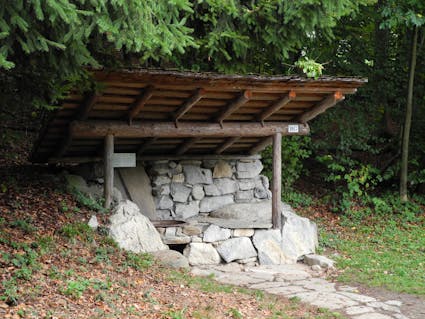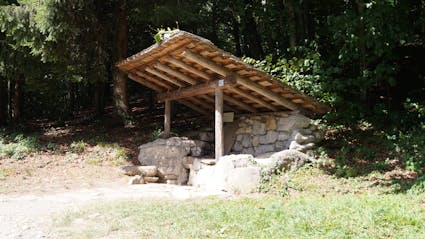1013 – Stove For Stewing Dock 19th Century (Reconstruction)
In many places in the Bernese Oberland there were so-called "Blachtenöfe". They remained in use until the 1920’s and 1930’s.

Unloved Weeds
Alpine dockweed grows rank on over-fertilized ground. It steals light and nourishment from other growth. Around stallings and cattle loafing sheds it keeps anything else from growing. Dock is called "Blacke" in Swiss dialect. Farmers destroy the weeds by digging the roots out with a weeder or use a weed killer. Such was not always the case.

Using the Useless
Formerly dock had many uses. The stalks were gathered and stewed in a big iron cauldron. They were then stored in troughs, wooden boxes or tubs as animal fodder – stewed dock resembled today’s silo grass. Stewed dock could be stored long term. In winter it nourished the hogs, in hard times it could even furnish humans with protein. The leaves had their everyday uses: they were used to seal covers on dishes or for packing butter and other things.
Fodder Substitute
In many places in the Bernese Oberland there were so-called “Blachtenöfe”. They remained in use until the 1920’s and 1930’s. The stove reconstructed in a shed at the Ballenberg Open-Air Museum in the 1970’s is based on prototypes from Adelboden. In this region they were only found at higher elevations. There were no planted fi elds there and therefore no grain waste for animal fodder. Alpine dock supplied a part of the hog feed.

Which Roof?
Saddle or ridged roofs were used for storehouses, stalls, barns, houses and chapels: at the top centre of the building the ridgepole rests on the gables. Left and right roof panels slope down to the eaves like a tent. It is the most common form of roof. The shed roof is different: a single roof panel slopes down from one side to the other. Shed roofs are less common but are used on rural utility buildings such as sawmills or grain mills, as well as on small buildings such as sheds and sties. In the mountains they are a measure against avalanche damage: the destructive air pressure and the heavy snow masses sweep over them in the same angle as the mountainside. The Open-Air Museum displays a few typical examples: in addition to this shed for the dock-stewing stove the cooling cellar (722), the pig sties from Wila (641), Blatten (1113) and Alp Champatsch (1314).
Ballenberg
Swiss Open-Air Museum
Museumsstrasse 100
CH-3858 Hofstetten bei Brienz
Opening hours
11 April to 27 October 2024
10 am to 5 pm daily